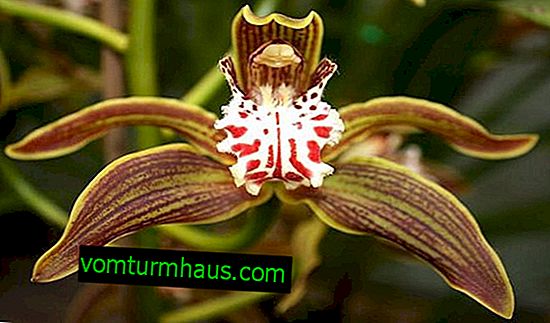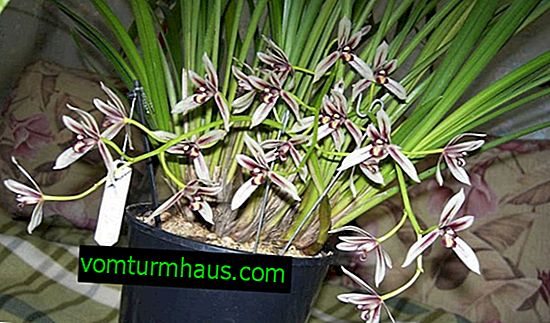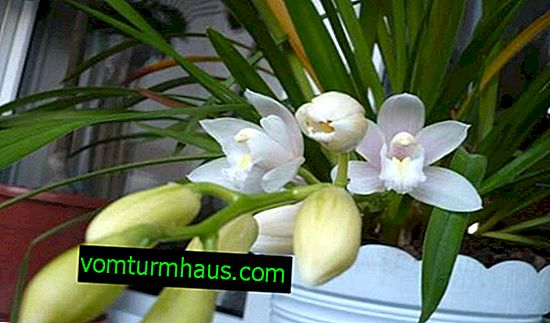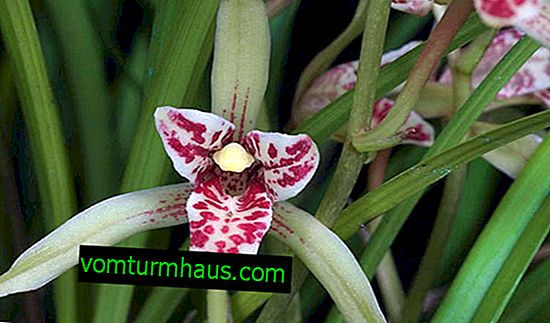How to care for cymbidium orchid at home
Orchid cymbidium attracts gardeners primarily because of its beautiful flowering. The rules for caring for the plant are quite simple, and a beginner grower must definitely get acquainted with them.
Botanical description of the plant
Orchid cymbidium in natural conditions most often grows on other plants, since it belongs to epiphytes.
The species under consideration is distinguished by long and narrow leaves, which continue to live up to dying (up to 3 years). On the stem are inflorescences consisting of flowers. Each variety has a unique color, which varies from light shades (white, light beige) to bright multi-colored.
Did you know? In vivo, cymbidium can be found in the Asian tropics and subtropics, as well as in the North Australian region.
Flowering lasts up to 60 days with proper care. The buds exude a pleasant aroma throughout the flowering period.

| Root system | Long, powerful |
| Stem | Tall, fast growing |
| Leaf shape | Narrow, long |
| Leaf color | Green |
| Flower shape | Depends on the variety, the petals are the same, have a crescent or lanceolate shape with a three-bladed lip |
| Flower color | White, light beige, pink, green, brown, yellow, red |
Varieties
Modern botanical science has several dozen varieties and hybrids of cymbidium.
It will be useful for you to learn how to grow orchids from seeds correctly at home.
The following are the most common ones:
- Aloeelist . The flowers are yellowish, the center of the petals is purple. The buds are small, up to 5 cm in diameter. The height of the bush is 30–40 cm.

- Giant . Inflorescences of this variety grow up to 60 cm. Each inflorescence has 15 buds, the diameter of which is 11–13 cm. The color is green-yellow with brownish impurities in the form of large veins.

- Daya . Flowers have a light beige color with cream tint. On the petals is a purple streak.

- Dwarf . A small plant, characterized by relatively short leaves, whose length reaches a value of 20 cm. The flowers are of medium size, the diameter of the largest specimens is 10 cm. The color of the buds is brown, the edges are yellowish.

- Lanceolate . Light green petals, in the center parallel stripes of brown color. The shape of the pseudobulb is spindle-shaped. Leaves grow up to 50 cm in length and 5-6 cm in width.

- Lowe . The buds are composed of petals that are yellow in color with a green tint.

- Mechaty . Leaves can grow from 30 to 90 cm. The buds consist of yellowish-green petals, in the middle of the vein a dark pink color.

- Ivory . The flowers are ivory close to white. Peduncle grows to a height of 30 cm.

- Tracy . It is distinguished by a height of 1 m, the buds are also quite large and on average have a diameter of 15 cm. The flowers are yellow in color, partly close to green.

Did you know? Cultivate the described species of orchids began in ancient China. Confucius noted their pleasant smell, which gave them the name “kings of aroma”.
House growing conditions
Orchid cymbidium needs to create certain conditions: the intensity and duration of flowering will depend on them.
Placement and lighting
The plant is photophilous. For good flowering, it is necessary to provide the cymbidium with a large amount of light. A window sill is best suited as a permanent place. However, you should avoid the south side, since too intense heating harms the flower.
The northern side is deprived of a sufficient level of light. Experienced growers are advised to put a pot of plants near a window that faces east, west or southwest.
Temperature and humidity
Cymbidium tolerates a short-term increase in temperature in the summer heat, but it likes moderate indicators more. For the plant, the temperature will be comfortable within +18 ... + 25 ° С. At night, a flowerpot from the end of summer to the end of autumn is best taken to the balcony to create a cooler temperature.
The temperature drops in this case should be at least 10 ° C - this will positively affect the formation of buds. In the winter season, it is preferable to switch to colder conditions - +15 ... + 18 ° C.
The moisture level in the air should be sufficient. Cymbidium is a hygrophilous species due to its tropical origin, however, it is not worthwhile to significantly increase the humidity in the room. Optimum hygrometer performance should be at the level of 50-60%.

Home Care
Regular watering, fertilizing and replanting are important in plant care. This ensures the correct development of the orchid and is important for maintaining its vital functions.
Watering
The soil of the cymbidium orchid should be moist: you need to water the pot at a time when the earth is still in a moist state. In winter, watering should become more moderate, but it is undesirable to allow complete drying of the soil.
You can only water the soil, spraying is not important. Water should be at room temperature. It is better to use settled or melt water.
Important! The soil must not be allowed to become excessively damp, because this can lead to decay of the roots, the appearance of brown patches on the peduncles and leaves and their subsequent death.
Top dressing
The plant needs to be fertilized with mineral fertilizers from the beginning of spring until it enters the flowering state. The frequency of fertilizers, which must be liquid, is with every third watering. Cymbidium is suitable for mineral-based top dressing in low concentration.
Transfer
It is better to transplant after flowering: the specific time is determined depending on the variety - most often it is spring. Cymbidiums, like other orchids, do not tolerate frequent transplants very well, so the procedure should be carried out once every 3-4 years.

The container for planting should preferably be made of clay. Its shape may be elongated. The main thing is to use a larger pot than the previous one.
After preparing the materials, you can proceed to the transplant, the sequence of which is as follows:
- Partially fill the new pot with substrate.
- Extract the plant from the pot.
- Peel and rinse the rhizome.
- Remove excess root parts, rinse and dry.
- Submerge the plant with rhizome in a new container with soil.
Find out what the composition should be and how to make a primer for orchids with your own hands.
Breeding
The propagation of cymbidium can occur by dividing the bush or sowing seeds. Each of the methods has its own characteristics in execution.
Dividing the bush
It is better to divide the bush in the spring season or immediately after flowering. First of all, you need to prepare containers for new bushes and fill them with substrate. Then you can start dividing.
To do this, follow these steps:
- Extract the plant together with the root from the soil.
- With a sharp knife, divide the rhizome into separate parts so that each has 1 growth point and 3 pseudobulbs.
- Immerse all parts in separate containers.

Seeds
Orchid seeds are extremely small and cannot sprout on their own after planting. For proper sowing, the material must be sterilized and constantly monitor the germination of seedlings. This method is used by breeders, but in domestic floriculture it is risky and practically not used.
Important! When sowing seeds, you will have to expect the appearance of flowers for at least 3 years.
Growing difficulties
When growing cymbidium, certain difficulties may arise that are easy to solve if the necessary measures are taken in time:
- Missing flowering. If there is such a problem, you need to pay attention to lighting and rearrange the flowerpot in a brighter place, if there is a problem of shading. If the lighting is in the correct mode, it is worth taking the container with the plant to a colder room at night, so that the temperature drops by 10 degrees.
- The leaves are dry . Most likely, the moisture level in the air is low. It is necessary to check the humidity level with a hygrometer and adjust the microclimate.
- Yellowing . If the cause of yellowing is not drying out the leaves, putrefactive foci on the root system may occur. The problem is treated by brushing the root and replanting the plant.
- The green part dropped . The reason for this most often lies in the insufficient level of light. The flowerpot needs to be moved to another place.
- Pests . Among the pests, aphids, scabies and spider mites can be distinguished. The leaves must be cleaned of plaque and lesions and treated with a systemic insecticide.
- Mosaic . This disease is manifested by blackening of the sheets and is viral, so when it occurs, cymbidium should be isolated or destroyed.
- Rot . Most often, the plant can be affected by gray rot, which manifests itself in the form of a grayish coating on the leaves. The reason is often spraying in a cool room. Affected parts must be removed, and healthy parts should be treated with systemic fungicide. In the future, watering should be adjusted.
- Anthracnose . It is characterized by the appearance of brown spots on the leaves. For treatment, it is necessary to get rid of the affected parts, reduce the frequency of watering and top dressing, adjust the temperature and spray with a systemic fungicide.













